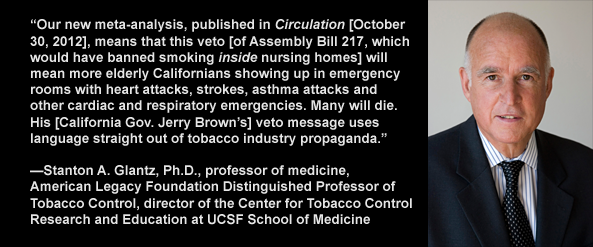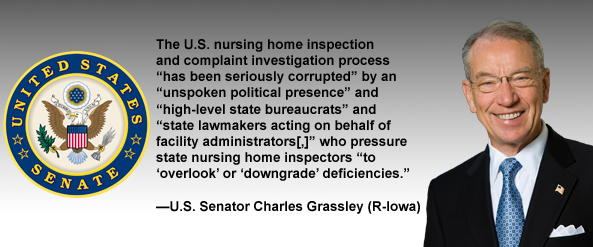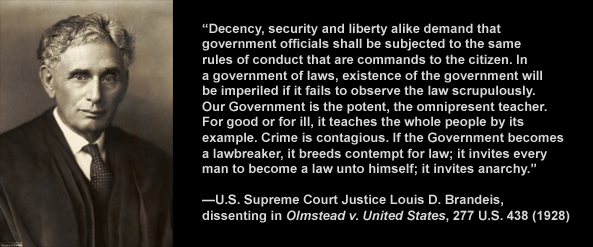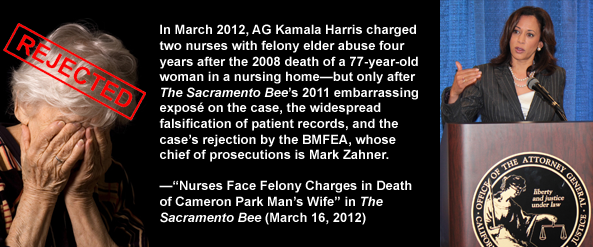
United States Attorney General Eric Holder speaking at a press conference alongside FBI Director Robert Mueller, in the public domain. (Photo credit: U.S. Department of Justice, October 11, 2011)
False Claims Act lawsuit against North American Health Care’s CEO, John Sorensen, continues, U.S. federal judge rules
A federal False Claims Act lawsuit filed against Dana Point, California-based North American Health Care Inc. (NAHC) and its CEO, John L. Sorensen, will continue, according to U.S. District Court documents and a recent article in McKnight’s Long-Term Care News.
The McKnight’s article, “Kickback Allegations against North American Health Care CEO ‘Plausibly Supported,’ Court Rules,” said on November 16, 2015, that John Orten, a former nursing home administrator and whistleblower who worked at one of the 36 “client facilities” that NAHC operates in the western Unites States, alleged the following in his False Claims Act lawsuit:
- “The CEO of North American Health Care Inc. personally oversaw a kickback scheme.”
- “CEO John L. Sorenson [sic] ordered other nursing home administrators to pay physicians in exchange for referring Medicare beneficiaries to NAHC facilities.”
- “[John] Sorenson [sic] paid physicians to sign letters written by NAHC employees that defended the company against deficiencies found by Medicare inspectors.”
False Claims Act allows private citizens to sue those who try to defraud the federal government
The False Claims Act (31 U.S.C. §§ 3729–3733) allows private citizens and whistleblowers to file a lawsuit, also known as a qui tam action, on behalf of the federal government against government contractors and others who allegedly try to defraud government programs, including Medicare. (See Elder Abuse Exposed.com’s coverage of rampant Medicare fraud by nursing homes throughout the United States in “Nursing Home Medicare Fraud $1.5B a Year, Says New U.S. HHS-OIG Report” and “Nursing Home Chain Life Care Bilked Medicare of Millions, DOJ Suit Says.”)
Plaintiff-relator “has plausibly alleged that Sorensen implemented a referral and regeneration scheme and that false claims were actually submitted,” U.S. federal judge says
According to records in the U.S. District Court for the Northern District of California, on July 17, 2015, John Sorensen filed a motion to dismiss the qui tam lawsuit for failure to state a claim specifically against him. Then in a ruling on November 9, 2015, U.S. District Judge William H. Orrick granted part of Sorensen’s motion to dismiss but denied part of it. “Orten has plausibly alleged that Sorensen implemented a referral and regeneration scheme and that false claims were actually submitted,” Judge Orrick said in his ruling, which has allowed the lawsuit against NAHC and Sorensen to continue.
North American Health Care Inc. filed for Chapter 11 bankruptcy protection
North American Health Care Inc. filed for Chapter 11 bankruptcy protection in February 2015, as The New York Times reported on February 17, 2015, in “Facing Suits, a Nursing Home in California Seeks Bankruptcy.” The bankruptcy protection was “necessitated by the barrage of alleged medical malpractice and other lawsuits filed against the Debtors, claiming damages in the millions of dollars against the Debtors,” NAHC has claimed in filings with the U.S. Bankruptcy Court for the Central District of California. NAHC has also alleged in the same court filings that “the aggressive litigation tactics of the plaintiffs in these lawsuits . . . have diverted the Debtors’ resources and focus away from operating their businesses.”
The cases in this article are:
- United States of America et al. v. North American Health Care et al., case number 3:14-cv-02401-WHO, U.S. District Court for the Northern District of California.
- In re North American Health Care, Inc., case number 8:15-bk-10610, U.S. Bankruptcy Court for the Central District of California.
What do you think? Please share your thoughts below this article!

If you take a moment of your valuable time to leave a relevant, non-spam comment below, we will reward you by telling Google and other search engines to crawl and follow your outgoing hyperlink pointing to your website.






